Case studies of some top-notch no-tillers (there are many).
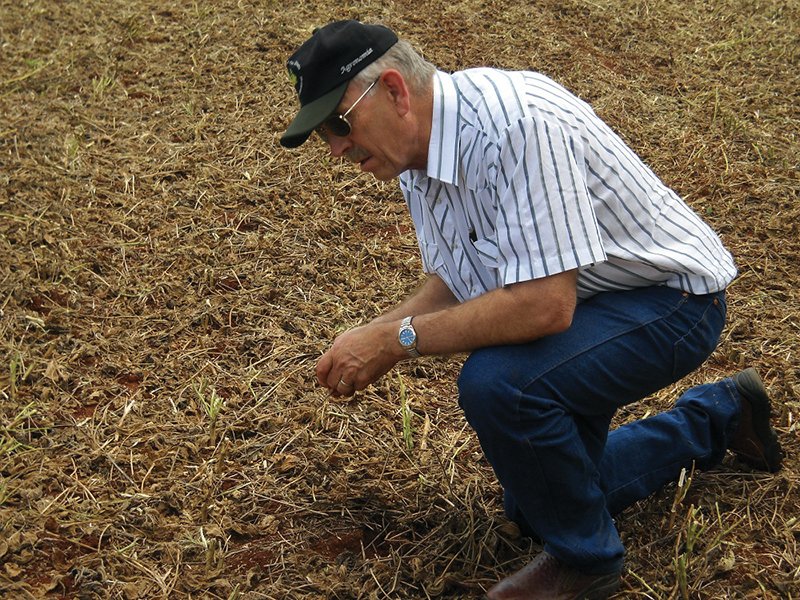
Kent Stones is one of the most financially savvy and successful farmers you’ll run across, and yet not every decision on his farm revolves purely around economics—sustainability plays a role as well. He and his wife, Cindy, are very committed to leaving the land in better shape than they found it.
And that encompasses quite a swath of land in north-central Kansas, from the Nebraska border to near Downs, KS, an operation scattered about 35 miles from north to south and nearly as far from west to east. Kent has always been aggressive about expanding, taking the farm from an initial 400 acres to its current size today (which is to say, a surprisingly large number of acres for the machinery he has; and since the implementation of never-till in ’96/97, he has way more than doubled its size). Along the way, Stones has actually turned down some opportunities to rent more land, saying that he prefers more manageable growth rather than huge jumps. He is quite the sought-after tenant, since his prowess at crop production is highly obvious to even a casual observer, as well as him being an upstanding member of the community.
Stones currently runs a wheat >>corn >>soybean rotation for the most part, saying that “One-third wheat is all we can afford,” a nod to the low price of wheat relative to corn and beans lately, as well as implying that he needs the wheat to control erosion (and weeds). But for 20+ years, he had made a habit of doing stacked wheat (two consecutive wheat crops, preceded by a long break from wheat). On a couple of challenging quarters of land, he’s wheat and corn only (no soybeans) due to erodibility—although he acknowledges, “There will be a doomsday with that rotation from disease.” (He sprays the wheat at bloom with a fungicide to minimize scab when it follows corn; he does this on about half his other wheat anyway—either at bloom, or flag leaf if disease is building rapidly.)
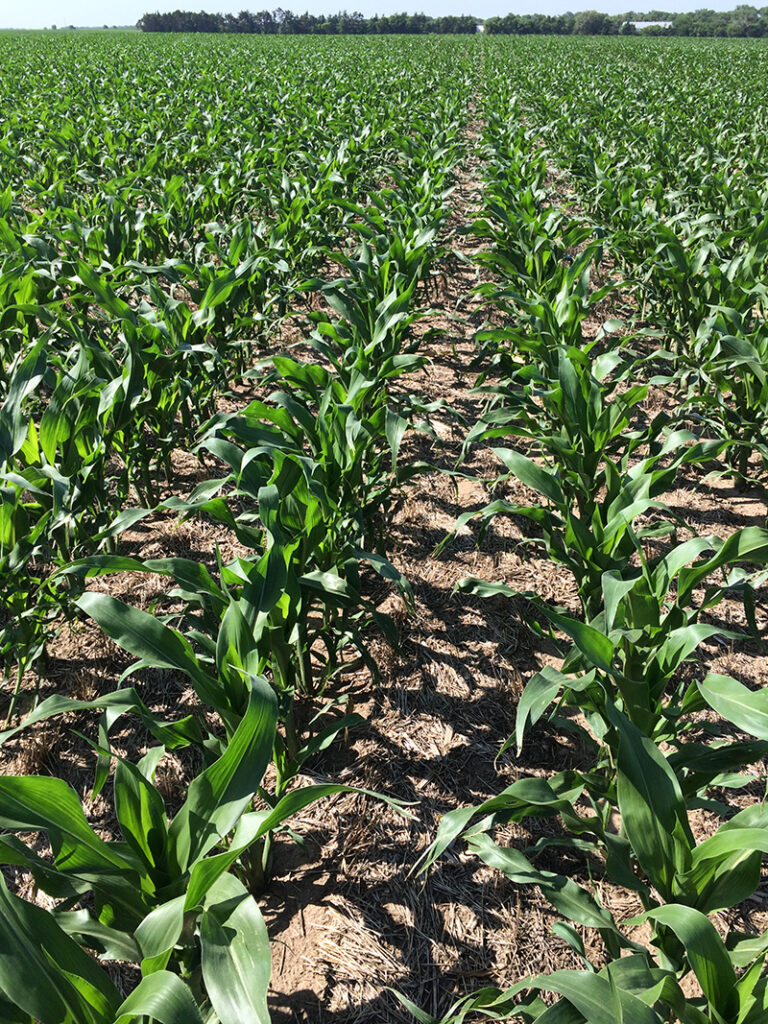
Remarkably, for a rather dry region, Stones was doing a lot of double-crop sunflowers, milo, and soybeans in the early 2000s. But when he first started no-tilling in ’96, Kent thought that the goal of wheat stubble was to build moisture for the following corn crop. He thought that they didn’t get enough in-season moisture during the corn’s life span for the crop to be viable, so they wanted the soil profile completely full going into corn planting. However, he noticed that when the profile was full, that sometime in the spring before the corn was 7-leaf (canopied), they’d have a 3- or 4-inch rain and have erosion problems. So, he started doing double-crops and cover crops in the wheat stubble to dry the soil profile (I had urged him along on his—Kent has been a client of mine for most of the years since ’96, although I haven’t scouted his fields for many years).
At first, it was mostly double cropping. However, Kent observed, “Double-cropping was only working well 2 years out of 5.” In ’09, they started getting serious about cover crops in that niche of the rotation (wheat stubble going to corn or milo) instead. That year, he did 100% of his wheat stubble being carried over for corn/milo, and spent nearly $30/a on cover-crop seed to do this. More recently, he’s been doing double-crop soybeans on fields that don’t have as much erosion issue, and the remaining wheat stubble is split between cover crops and setting idle until spring. About 4 years ago, he settled on the fine-stemmed grass species (mostly pearl millet currently, but tried teff in the past on a sizeable acreage) as being optimal for what he’s trying to accomplish in this niche (wheat stubble going to corn or milo), and spending about $8 – 9/a on seed to do this, saying he needs to be frugal to stay profitable. He’s also used proso millet but probably won’t use it anymore; the same goes for teff. He will often blend in a light rate of sudan with the pearl millet. “Brassicas and legumes in summer covers don’t provide the erosion control that we need. I really like pearl millet—it’s vigorous, and we get good results with it.”
The pearl millet is seeded as soon after wheat harvest as is practical, and Kent will dust it in if need be. “If we wait till the 3d or 4th week of August, we don’t get enough growth.” (Note: I’d be leery of dusting in these warm-season species in July/Aug in his climate—what if it doesn’t rain on them until Sept? Then you’ve trampled a lot of stubble to seed something that isn’t going to produce enough durable residue to replace what was trampled. I’d wait for moisture, and if it got too late for pearl millet, I’d switch to oats.)
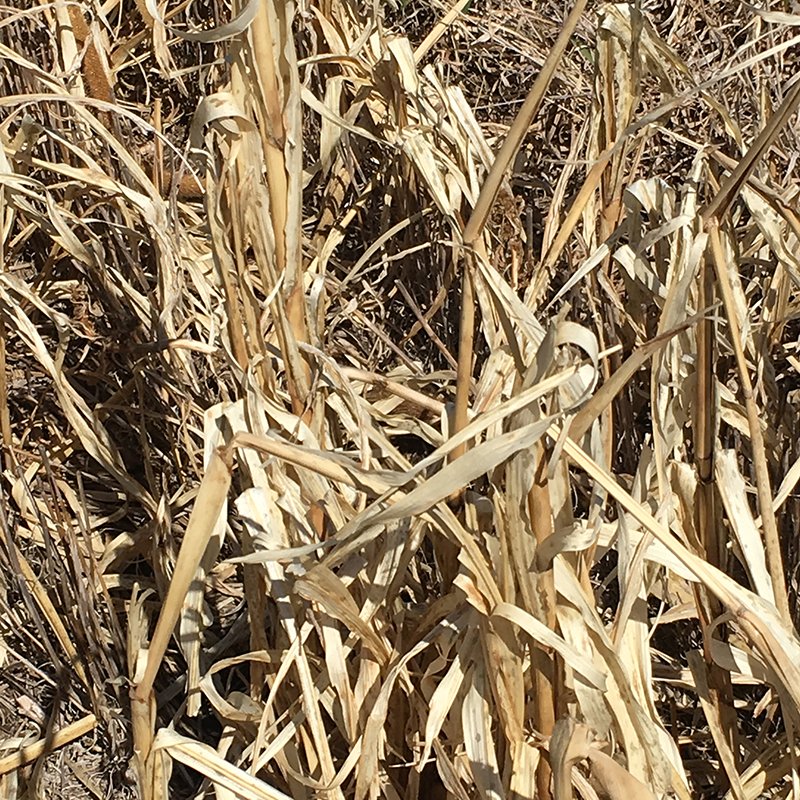
Kent says, “With cover crops, I have more questions than answers. I’ve never recovered my costs on a cover in a single season. But there might be cumulative effects [there is some evidence of this]. And, in most years, the profitability reduction is justified and acceptable. On the average years, we obtain higher corn yields on the cover-cropped stubble as compared to clean [idle] stubble.” Which lends credence to his previous observation that having the soil moisture profile completely full at corn planting wasn’t necessary or desirable. He does use an extra 30# of N where the corn follows a grass cover (millet, teff), and wonders if that’s enough (probably not) to make use of all the extra moisture being stored by the extra cover (after the grass cover dies, the heavier cover is more efficient at storing the precip that occurs from then onward, including while the corn is growing; water-use efficiency in the corn is further enhanced by keeping the soil surface cooler in the hot Kansas months, and by building up mycorrhizae to explore more of the soil and bring that water to the corn crop).
In other rotational developments, Stones did a fair amount of stacked corn in years past, but quit, saying, “We weren’t getting the erosion control we needed. And there was usually a 5 – 10% yield reduction on the stacked corn [although it was often cheaper to grow this stacked corn than corn into wheat stubble because of eliminating the cost of keeping wheat stubble weed-free and drying it out with covers].”
While 25 years ago, Kent grew far more milo than corn, the past two years [2016 & 2017] his milo acreage has been zero. Corn has simply been too good to him economically, and it’s far easier to control weeds such as shattercane and glyphosate/triazine/ALS-resistant Palmers. And back in the ’90s, he grew a lot of full season sunflowers but has since moved entirely to soybeans for easier weed control and improved yields in the wheat following the broadleaf crop (in drier regions, winter wheat yields more following soybeans than sunflowers).
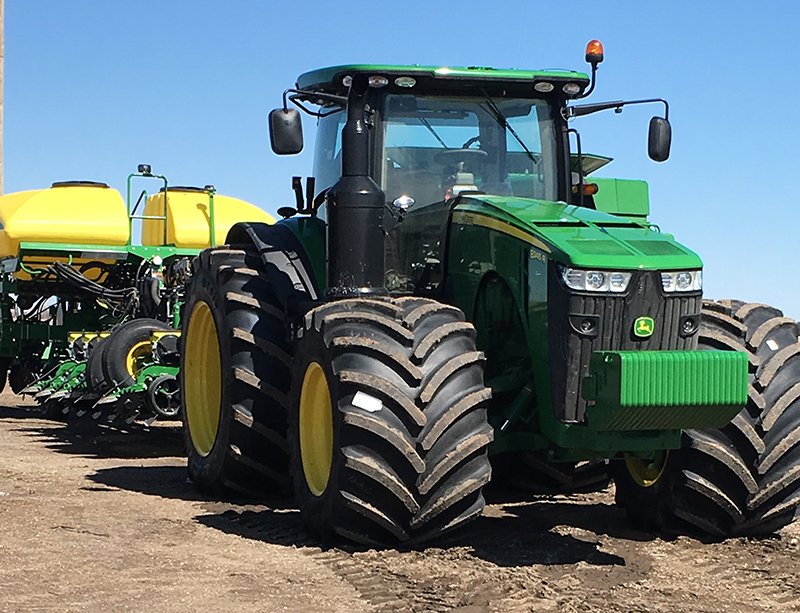
One of the early adopters of precision ag, Stones has been yielding mapping since the mid-’90s, and doing VR fertilizer builds since 2010, and VR populations on corn since 2012. They grid-sample about 20 – 30% of their land each year and are on their second time around for VRing dry fertilizer b’cast. He likes to maintain P levels about 25 ppm on Bray-1 or Mehlich-3. He attempts to build Zn levels also.
Wheat gets 150# MESZ pop-up with the drill. Stones has a 90-ft bar that goes behind his JD air cart to top-dress the wheat with urea. (This year, he went with liquid streams on the surface, due to a huge price disparity; previously, it has almost always been urea.)
Stones doesn’t run any pop-up for corn, somewhat surprisingly, but he notes that he really doesn’t plant corn all that early anymore: “Our corn planting dates are moving down the calendar. We don’t have any yield loss until the 10th of June planting date. Third week of May onward often out-yields April and early May plantings.”
Instead, corn fertilizer is applied as dry product (urea, etc.) pre-plant, with some additional liquid fertilizer (N, P, S, Zn) applied sideband with the planter. “If I was 20 years younger, I’d put it all on with the planter. But our nutrient removal has been so humongous the last 10 years, I can’t keep up. Previously we did 40 gallons/acre of product thru the sideband. Now, I can’t get it all done with 55 gallons!”
For many years, this side-band liquid was applied thru Martin UMOs (side-band openers mounted to the front of the planter row unit), but last year [2017] he finally hit the wall and was unable to keep them going—they just plugged with straw far too often. So, he switched mid-season to simply dribbling it on the soil surface with tubes running behind the closing wheels on his planter. He plans to continue this, “There’s just no substitute for good, heavy standing stubble. We knew the UMOs were knocking down more stubble than we cared to see, but the plugging was the final straw.” Pun noted 😀!
Surface-applied N too risky? No, Stones says, “I’ve never had trouble with surface applied.” He continues with a story, “Back in the early 2000s, a [respected] K-State agronomist and the local co-op had a meeting. I wasn’t invited. Later that day, they went out on a tour of some fields, including one of mine, and my recently applied urea prills were still visible on the surface. The K-State agronomist commented on how foolish this practice was—that this was just throwing money into the air. Two years later, this co-op started buying air booms and have been applying urea on the surface ever since.”
On soybeans, contrary to corn, Stones keeps pushing planting dates forward—going as early as April 15th. He says, “We like to be done with beans before we start corn, and it’s been quite a few years since our farm average on beans was less than 50 bu/a.” His soybeans go in on 15-inch rows with a 43-ft JD 1890, which is equipped with Exapta’s Thompson wheels. (He’s considering switching it to 10-inch from 7.5-inch.) “We would really benefit from UniForce, I just haven’t pulled the trigger yet.” He has been using various JD 50/60/90 air drills almost exclusively since he started no-tilling, with the exception of a Concord with shanks on some acres his first year, and a brief stint with a modified Flexi-coil FSO drill from ’99 – ’01 which was a maintenance nightmare, although it had excellent seed placement characteristics especially after a Keeton was added.
Stones originally began no-tilling with a CIH Early Riser planter in the mid-’90s but quickly moved on to a Flexi-coil that used Kinze row units (again, he added a lot of upgrades and mods to make it work properly in no-till). Since then, it has been Deere planters (again, with plenty of attachments). For 2018, he’ll be taking a new 16-row Deere ME5 to the field, with Yetter Sharktooth row cleaners (on air-adjustable CleanSweep brackets), Quick Attach Keetons + Mojos, and Thompson closing wheels with toe-out wedges. The planter has Dawn’s Reflex hydraulic downforce, as well. On his Deere planters, once the OEM seed tube guard wears out, they get replaced with Exapta’s Valions. He really likes running MudSmith gauge wheels on both the planter and the drill.
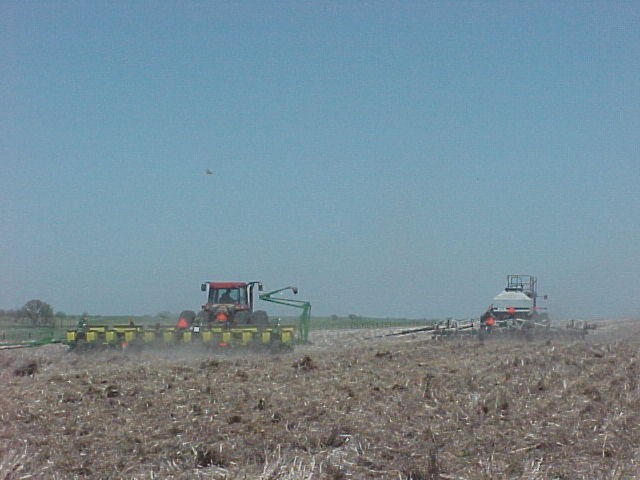
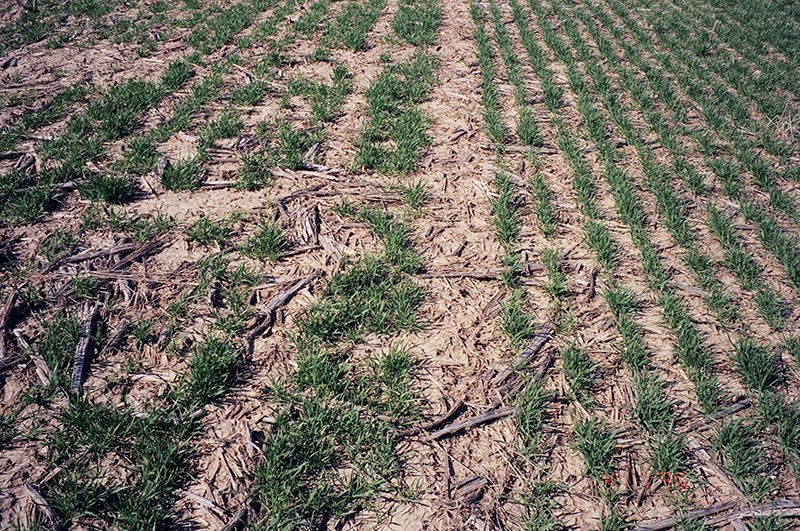
What challenges is Kent’s operation currently facing? In addition to battling erosion and struggling to stay profitable with today’s low grain prices, he has a couple other fronts that are of concern. One is compaction, and with his ever-expanding acreage, he’s needed continually to go to larger machinery—which is also heavier. Is ripping the answer? Probably not, he says. Last year, his employee ripped a few areas of a field that the employee owned but leased to Kent, and Kent says it was very apparent in the combine—those ripped spots were lower yielding. Also, before transitioning to no-till in the ’90s, a fair number of Kent’s fields were deep-ripped. Fields that were acquired later weren’t ripped, and yet there’s not been any perceptible yield difference.
While Kent did seriously entertain ripping his established no-till fields in ’09 after another consultant found some rooting issues, he chose instead to get serious about limiting any additional compaction, and let nature slowly heal the damage. He runs tracks on the grain carts, and large LSW (Low SideWall) tires on the tractor, combines, and sprayer. This lets him get down to recommended inflation pressures of around 17 psi for the sprayer and combine, which he knows is still too high (especially for the sprayer). Part of the problem is that he’s running a 1200-gallon sprayer, and sometimes two of them, just to be able to cover the acres in a timely manner (an increasing problem recently because of the high gallonage required for paraquat—he can’t kill Palmers in wheat stubble any other way—and Liberty on the LL beans he grew in 2017). He’s considering doing something for larger tires on his air cart on his drill (he notes that he deliberately limited himself to a 275-bu cart for this reason). Despite these steps, Kent says, “We’re still looking for solutions. We need to quit making it worse.” He notes that severe compaction will persist for decades, if not centuries.
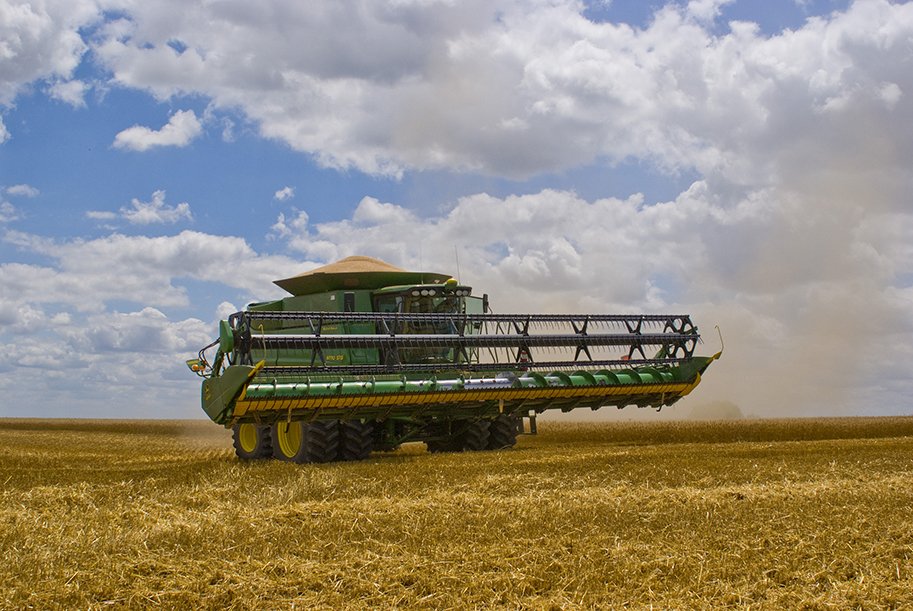
Later, he converted to LSWs.
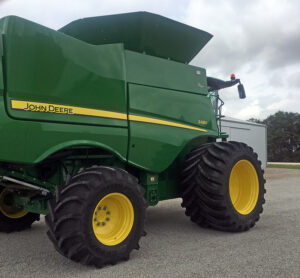
Another major challenge that surfaced in recent years on the Stones farm: glyphosate-resistant Palmers. And these same plants are ALS- and triazine-resistant (we’ve had triazine-resistant Palmers for 20 years in parts of Kansas—the Deep South has it easy in that their Palmers are still susceptible to triazines!). Because the glyphosate resistance is carried by pollen for dozens of miles, it blew up all across his farm in a single year. Thus, all his wheat acres need paraquat at least once (more if they’re kept idle).
Where things get really tricky is keeping the Palmers out of his soybeans. Kent uses aggressive pre-plant chems, often 3 different modes of action—but he observes that this is rarely satisfactory (for Palmers that threaten his farm’s viability, he wants 100% control and makes that his goal): “We need some means of coming back and controlling escapes before they make seed.” He has used rogueing crews on a large scale in the past and liked what they did—but notes that it’s impossible to find all the ones down in the canopy, so the crew really needs to come back 3 weeks after their first round. Due to the difficulty of getting the crews in a timely manner, he’s going to attempt to do it all with herbicides in 2018. He observed that last year, “very few Palmers got away from us in the Liberty [Link] and dicamba [Xtend] beans” due to the in-crop application of Liberty or dicamba, whereas his RoundupReady beans had more escapes. This year, he’s going 100% Xtend in his beans for simplicity, but might be 100% LibertyLink or Enlist E3 in 2019.
Would he ever run a $100,000 seed destructor on his combines to help? –“In a heartbeat, if they were shown to be effective at killing nearly all the Palmer seeds and were reasonable in the amount of maintenance required.” Taking a different perspective, he remarks, “If we can’t solve the Palmer problem in soybeans, we’ll have to quit soybeans.” Even though that’s still a highly lucrative crop for him, despite the additional herbicide costs.
What does Kent consider one of his key mantras for success? “We keep it fairly elementary. We don’t get too flowery. It has served us well.” Expanding on this, “If we’re going to implement practices that really move the [profit] needle, we need to focus on those that have greater than 10% returns, on average. We’re just so climate-variable [prone to droughts]. If the expected [average] return is less than 10%, we don’t bother.”
“We make changes incrementally. Everybody’s program needs to evolve year after year—we have to keep progressing.” So, Kent experiments a lot, including some crazy stuff (like seeding corn with a drill), but keeps it small-scale until he has a couple years of experience with it.
Note: Some of Kent’s experiences during his early years of no-till are described in this Leading Edge cover story and the follow-up article five years later (scroll down to page 21 of the pdf, aka p ‘341’).

